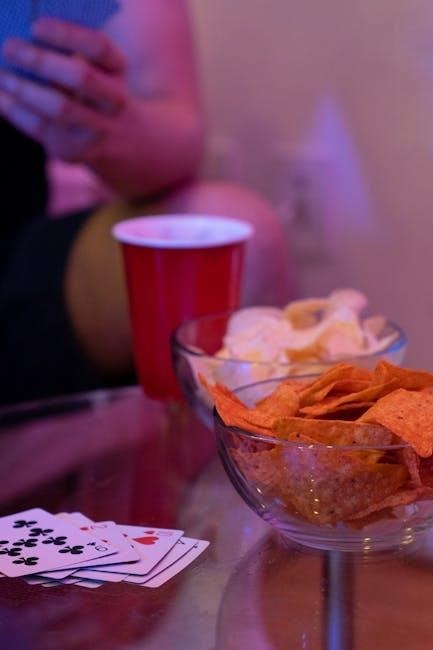Hand‚ Knee‚ and Foot is a dynamic rummy-style card game‚ often compared to Canasta‚ offering a mix of strategy and fun for 2-6 players. It involves managing three sets of cards—the Hand‚ Knee‚ and Foot—each with unique roles in gameplay. This engaging game is perfect for those who enjoy complex card strategies and teamwork‚ making it a great choice for social gatherings or competitive play.
Background and Relation to Canasta
Hand‚ Knee‚ and Foot is a variation of the popular rummy-style card game Canasta‚ known for its strategic depth and teamwork. Originating in South America‚ it evolved into a unique multi-deck game. While Canasta typically involves two decks‚ Hand‚ Knee‚ and Foot expands the complexity by incorporating three sets of cards‚ making it a dynamic and challenging variant. The game retains core rummy elements‚ such as melding cards‚ but introduces additional layers of strategy with its three-card setup. This variation is particularly popular in North America and is often played in social and competitive settings.

Game Setup and Requirements
Hand‚ Knee‚ and Foot requires 2-6 players‚ using one more deck than the number of players (including jokers). The game involves three sets: Hand (15 cards)‚ Knee (13)‚ and Foot (11). Proper setup ensures balanced play and strategic depth for all participants.
Number of Players and Teams
Hand‚ Knee‚ and Foot is designed for 2 to 6 players‚ with teams formed based on the number of participants. For 6 players‚ the game is typically played in teams of 3‚ while smaller groups can adapt with fewer players. The number of decks used increases with more players‚ ensuring ample cards for melding. Each team works collaboratively to manage their Hand‚ Knee‚ and Foot sets‚ making communication and strategy essential for success. The flexibility in team size allows the game to suit various social or competitive settings.
Deck Requirements and Initial Deal
Hand‚ Knee‚ and Foot requires multiple decks of cards‚ with the number increasing based on players. For 2-3 players‚ 3 decks are used‚ while 4-5 players need 4 decks‚ and 6 players require 7 decks. Each player receives three sets of cards: the Hand (15 cards)‚ the Knee (13 cards)‚ and the Foot (11 cards). The dealing process starts with a draw to determine the dealer‚ who then distributes the cards accordingly. The Foot cards remain face down until the Hand and Knee are melded‚ adding a strategic layer to the game. Jokers and deuces often serve as wild cards‚ enhancing gameplay complexity.

Objective of the Game
The primary goal is to be the first player to meld all cards in your Hand‚ Knee‚ and Foot sets. Melding requires forming valid sets or runs‚ and the game continues until a player successfully melds all their cards‚ winning the round. The challenge lies in strategically managing multiple sets while utilizing wild cards effectively to achieve this objective. The game rewards quick thinking and strategic planning‚ making it both enjoyable and mentally stimulating for participants.
Melding Cards and Winning Conditions
Melding is the core of the game‚ requiring players to form valid sets or runs of cards; A set consists of three or more cards of the same rank‚ while a run is three or more sequential cards of the same suit. Wild cards‚ such as jokers and twos‚ can substitute for missing cards in a meld. To win‚ a player must meld all cards in their Hand‚ Knee‚ and Foot sets. The game ends when a player successfully melds all their cards‚ earning bonus points for completing the meld first. Teamplay requires coordination to maximize points and achieve victory.
Types of Melds and Special Rules
In Hand‚ Knee‚ and Foot‚ melds are categorized into sets and runs. A set consists of three or more cards of the same rank‚ while a run is three or more sequential cards of the same suit. Wild cards‚ such as jokers and twos‚ can substitute for missing cards in a meld. Special rules include bonuses for natural melds (without wild cards) and penalties for holding unmelded cards. Additionally‚ a “book” requires three natural cards of the same rank to complete. Strategy revolves around effectively using wild cards and completing melds before opponents.

Gameplay Rules
Gameplay involves turns where players draw cards‚ meld sets or runs‚ and discard. The sequence starts with the Hand‚ then Knee‚ and finally Foot‚ strategizing with teammates is crucial.
Sequence of Play and Turn Structure
Play begins with the Hand‚ followed by the Knee‚ and concludes with the Foot. Each player draws a card‚ then attempts to meld cards from their current set (Hand‚ Knee‚ or Foot). After melding‚ a card is discarded. The sequence ensures strategic planning‚ as players must manage their cards efficiently across all three sets. Team communication is vital to coordinate melds and optimize card usage. The turn structure promotes dynamic gameplay‚ requiring players to balance immediate moves with long-term strategies to achieve victory. Proper coordination enhances chances of success in this engaging card game.
Card Drawing and Discarding
Players begin their turn by drawing a card from the deck or the discard pile. After melding‚ a card must be discarded to maintain the same number of cards in hand. Discarding strategically can disrupt opponents or signal potential melds to teammates. Drawing multiple cards‚ such as three‚ can accelerate the game‚ provided all players agree. Proper card management is crucial‚ as efficient drawing and discarding directly impact gameplay and opportunities to meld effectively‚ ensuring smooth progression toward victory. Clear communication among teammates enhances discard strategies‚ optimizing gameplay dynamics.

Scoring System
Points are awarded for valid melds‚ with bonuses for completing all melds or having specific card combinations. Penalties apply for unmelded cards after going out.
Points for Melds and Penalties
Each meld earns points based on the cards used. Red threes are worth 500 points each‚ while natural and wild sets contribute varying values. Penalties apply for unmelded cards after going out‚ deducting points for each card left in hand or foot. Illegal moves‚ such as invalid melds‚ also result in penalties. Proper scoring ensures fair play and incentivizes strategic meld management. Balancing points and penalties is key to mastering the game and securing a win for your team. Clear communication and careful planning are essential to minimize penalties and maximize points.
Bonuses and Special Scoring
Bonuses are awarded for exceptional achievements in the game. Completing all three sets—Hand‚ Knee‚ and Foot—earns a major bonus. Red threes are highly valued‚ each worth 500 points‚ and collecting all four can grant an additional bonus. Special scoring applies for going out first‚ rewarding players for efficient play. Some variations include bonuses for depleting the stockpile or achieving specific meld combinations. These incentives add layers of strategy‚ encouraging players to aim for more than just basic melds and enhancing the game’s competitive appeal and excitement.
Winning Strategies and Tips
Mastering Hand‚ Knee‚ and Foot requires skillful meld management and strategic planning. Communicate effectively with teammates to coordinate melds. Focus on high-value cards like red threes and aces. Use jokers wisely to complete challenging melds. Prioritize depleting your foot first to minimize penalties. Adapt your strategy based on the cards left in the stockpile to maximize your chances of winning.
Effective Meld Management
Effective meld management is crucial for success in Hand‚ Knee‚ and Foot. Organize your cards to identify potential melds early. Prioritize completing sets and runs to earn points. Use jokers and wild cards strategically to fill gaps in melds. Communicate with teammates to coordinate meld completions. Monitor the stockpile to anticipate opponents’ moves. Plan ahead to ensure you can deplete your hands efficiently‚ minimizing penalties and maximizing scoring opportunities. Proper meld management can significantly enhance your chances of winning the game.
Team Communication and Tactics
Team communication is vital in Hand‚ Knee‚ and Foot‚ as coordination between players can lead to victory. Signal strategies and potential melds discreetly to avoid tipping off opponents. Plan together to complete sets and minimize penalties. Agree on tactics like holding wild cards for critical moments. Discuss priorities to focus on high-value melds. Adapt your approach based on the game’s progression and opponents’ moves. Effective teamwork and clear communication can significantly enhance your chances of winning‚ making collaboration a cornerstone of success.
Game Variations and House Rules
Hand‚ Knee‚ and Foot offers flexibility with various play styles. House rules often modify deck sizes or wild card usage. Triple Play is a popular variation requiring multiple decks. Teams can adjust rules to suit their preferences‚ ensuring the game remains dynamic and enjoyable for all players.
Alternative Play Styles
Hand‚ Knee‚ and Foot can be adapted to suit different preferences. Alternative play styles include using multiple decks‚ varying team sizes‚ or adjusting wild card rules. Some players introduce special melding requirements or bonus points for unique combinations. House rules often emerge to make the game faster or more challenging. These variations allow the game to evolve‚ keeping it fresh and engaging for players of all skill levels. Whether simplifying or complicating‚ alternative styles ensure the game remains exciting and adaptable to any group’s preferences.
Custom Rules for Different Groups
Custom rules can enhance the game’s appeal by tailoring it to specific groups. Some players opt for relaxed melding requirements or introduce wild cards to simplify gameplay. Others prefer stricter rules‚ such as disallowing certain combinations or increasing the number of cards drawn. Groups may also adjust the number of decks or modify scoring systems to suit their preferences. These variations allow the game to be more inclusive or competitive‚ ensuring it remains enjoyable for players of all skill levels and interests.
Hand‚ Knee‚ and Foot offers a thrilling blend of strategy and camaraderie‚ making it a must-try for card game enthusiasts seeking both challenge and fun.
Appeal and Encouragement to Play
Hand‚ Knee‚ and Foot is a captivating card game that combines strategy‚ teamwork‚ and excitement‚ making it ideal for social gatherings or competitive play. Whether you’re a seasoned player or new to rummy-style games‚ its unique structure and dynamic gameplay offer endless entertainment. The ability to play with varying group sizes adds flexibility‚ while the blend of luck and skill ensures everyone can enjoy the challenge. Dive into this engaging game and experience the thrill of melding‚ strategizing‚ and bonding with friends and family in a fun‚ fast-paced environment.
